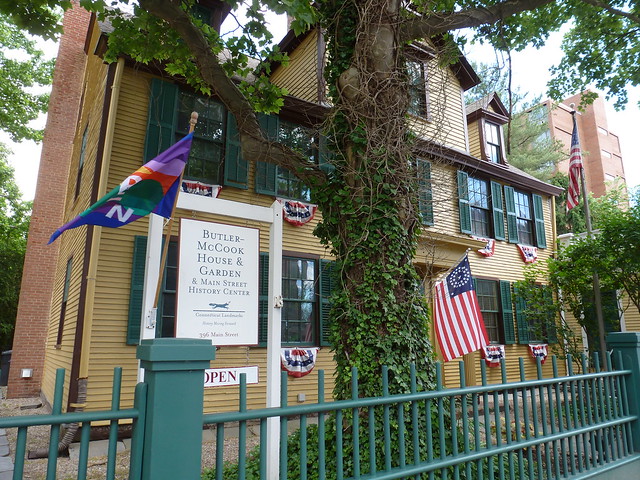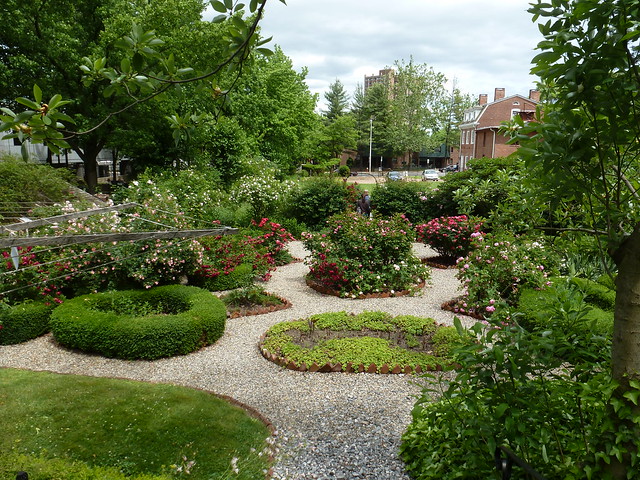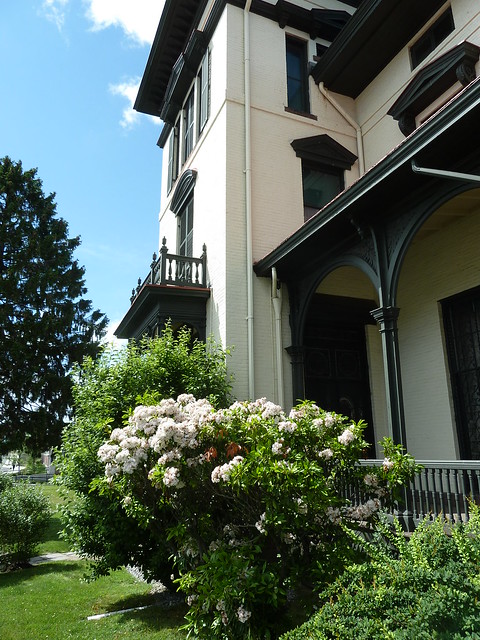First, we took a tour of the Butler-McCook House and Garden and Main Street History Center, which, as its name implies, documents two hundred years of Hartford history through the eyes of a single family. The main part of the house was built in 1782 and is now one of only four surviving 18th-century structures in Hartford, and the only 18th-century building still standing on Main Street in the capitol city. It sits on a corner, now literally dwarfed on all sides by surrounding twentieth-century constructions, its restored Victorian back garden the only buffer against the encroaching modern world.
The Butler-McCook House.
The Butler-McCook House is a truly unique museum experience because the house remained in the same immediate family throughout its entire history. Its rooms and attics are thus full of centuries of family heirlooms, from furniture to generations of childrens' toys to portraits and photos to the family art collection to souvenirs from the Civil War and trips abroad. Photographs and the oral accounts of the last surviving member of the family have enabled the museum staff to return every room in the house back to its appearance in the latter decades of the 19th century, when the house was home to Eliza Bulter, her cousin/husband John McCook (one of the famous "Fighting McCooks" from the Civil War), and their large family.
The back of the Butler-McCook House.
Frances McCook, the last surviving daughter of Eliza and John, remained unmarried and lived in the house her entire life. Before she died in 1971 at the age of 94, she gifted the property with the house and all its contents to the Antiquarian & Landmarks Society (the earlier name for the current CT Landmarks). Realizing the incredible importance of the multi-generational collection surrounding her in the house, she stipulated that it be preserved and opened as a museum to honor both her family and the early history of Hartford. Her immense appreciation for history led her to record an extraordinary set of oral histories recounting all of her memories, from the stories her elderly aunt and parents used to tell, to her own remembrances of growing up and living in Hartford her entire life.
The restored 1865 Jacob Weidenmann garden behind the Butler-McCook House.
If you're interested in reading more about the family and the house, check out the excellent article at this link and be sure to plan a visit to the Butler-McCook House the next time you're in Hartford! I plan to visit again with Ashley the next time she's home because this little museum represents something truly special, and I know she'll love it!
The Isham-Terry House.
The second CT Landmarks property we visited in Hartford on Saturday was the Isham-Terry House. Less than a mile from the Butler-McCook House and a short hop off Main Street, the Isham-Terry property sits somewhat precariously perched at a major intersection and entrance ramp to an interstate highway. Its house and tiny yard look like a mirage amidst the pavement, concrete, and brick that was sprung up around it over the centuries.
The Isham-Terry House shares a number of commonalities with the Butler-McCook House; indeed, the two families were friends and owned neighboring summer houses on CT's shore. The Isham-Terry House, originally constructed in 1854 in the then highly-fashionable Italianate style, was purchased by Dr. Oliver Isham in 1896, who used it both as a residence and as his medical office. Isham moved into the home with his elderly parents and two of his unmarried sisters, Julia and Charlotte; when the parents died, the sisters remained with their bachelor brother as housekeepers and receptionists for his busy practice. When Dr. Isham died in 1949, his two sisters continued to live in the house, staunchly refusing to allow it to be sold to and destroyed by modern developers. Julia passed away in 1977 and Charlotte in 1979, but not before they ensured that both the house and its contents would be preserved, much in the same way that their neighbor, Frances McCook, had guaranteeed the survival of her own family home.
Because the Isham sisters were passionate about history and their family genealogy, they made little changes to the house over the decades, carefully preserving its original details and the antique and family heirlooms in their care. So proud of their personal history were they that when they decreed that the house should become a museum to continue that heritage, they stipulated that it be called the Isham-Terry house because their mother's family, the Terrys, were descended from William Bradford (of Mayflower fame) and also related to the family of state hero Nathan Hale.
The house has only very recently been re-opened to the public, and is well worth a stop for its beautifully-preserved Victorian architectural details (including a tower), stained-glass windows, and antique furnishings. You can read the houses's nomination form for the National Register of Historic Places here; it gives some fascinating insights into both the family and the house itself.
Additional photos can be found in our CT Open House Day 2013 flickr set. For more information on visiting any of the CT Landmarks properties or in joining the organization to aid their preservation efforts, visit their website.







No comments:
Post a Comment